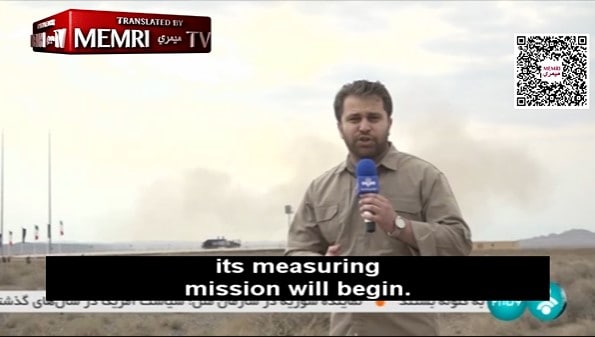
On September 27, 2023, IRINN TV (Iran) aired a show celebrating the launch of Iran's Nour-3 satellite into orbit. Iranian Space Energy chief Dr. Hassan Salarieh said that Iran will achieve higher image accuracy with its satellites and launch many satellites in the near future. General Ali Jafarabadi, commander of the Space Division in the IRGC Aerospace Force, said that the Nour-3 is more advanced than its previous versions and that this is the first time space thrusters were used by Iran.
Newscaster: "The Nour-3 satellite has been launched into space. Once it stabilizes in orbit, 450 km above ground, its measuring mission will begin. The Qased three-stage launcher has taken Nour-3 to space. In the first stage, the launcher has led the satellite for 70 km, and in the second stage, it led it for 350 km. As for the launcher's final stage, it was activated at an altitude of 450 km, and brought the speed of the launch from 5,200 m/s to 7,600 m/s. All of this was accomplished in 500 seconds, and eventually, a message arrived from the Chabahar base: 'Praise be to Allah, the altitude and velocity have been achieved.' Qased was charged with the main mission of the launch. This satellite launcher has already launched Nour-1 and Nour-2, and has now become suitable for all satellites weighing less than 50 kg."





Dr. Hassan Salarieh: "In the near future – and this has been published in various places – achieving satellite imagery accuracy of 2, 2.5, and 4 meters is on the agenda. The relevant contracts have been signed, and currently, we are at the research and working stages. Inshallah, we expect that by the end of 1404 [beginning of 2026 CE], we will be able to take very significant steps with regard to imagery accuracy of one meter as well. At the very least, we will be able to seriously start the research stage. In the near future, we will launch many satellites with image accuracy of 5, 4, and 3 meters."


[...]
General Ali Jafarabadi: "What has now taken an hour, took two weeks with the Nour-1 satellite, because that was our first attempt. With regard to the technologies that have been used, the camera of the Nour-3 is immeasurably better than that of Nour-2. It was manufactured, with honor and pride, by an Iranian start-up company, and its imagery accuracy is 2.5 times better than that of Nour-2. One technology that has been used in Nour-3 for the first time by the Islamic Republic is that of space thrusters. These are very sensitive space motors that generate forces that allow the satellite to modify its orbit, or, in other words, to perform an orbit maneuver, and prevent the satellite from losing altitude. They were manufactured by our experts, using elite all-Iranian technology. Nour-3 is the first satellite to use these thrusters, which inshallah will be also used in future satellites.



[...]
"The satellite [launcher] is a hybrid. Its first stage uses liquid fuel, and it was built by our dear brothers in the Defense Ministry. Well done! The motors of the second and third stages are solid-fueled space motors, which were built by the Research and Development division of the IRGC aerospace force. I am glad to say that they operated very successfully in the last three launches. In the future, these motors will launch many satellites to space. The Qased satellite launcher..."



Interviewer: "Footage of it is being aired now..."
Jafarabadi: "Yes. The Qased satellite launcher... I can explain over the footage, if you can enlarge the image. Look, these are the cameras that were installed inside the satellite launcher. This is the first-stage motor that ignited and is getting further away from the ground. It is passing through the clouds and bringing the launcher to an altitude of 70 km.
[...]
"Here I think that the second-stage motor has ignited. The first-stage motor turned off, and here the second-stage motor is igniting. You can clearly see the Earth in the background of the launcher. The second-stage motor is the same 'Salman' solid-fueled motor that General Hajizadeh unveiled a few years ago. It ignites for 60-70 seconds, and raises the launcher's velocity to 5,200 m/s and its altitude to 450 km. Here, the second stage wants to disconnect. The second stage brought [the satellite] to an altitude of 450 km, and now the disconnection command arrives, and the second-stage motor disconnects from the launcher."


Interviewer: "And the satellite enters orbit? Or the velocity..."
Jafarabadi: "Yes, later on. The second-stage motor disconnects. This is the disconnecting of the second-stage motor, and now, the third-stage motor should ignite. This is also a solid-fueled motor with composite body, and a varying thrust range. We are talking about the latest technology. Now, the third-stage motor has ignited. Its only purpose is to bring the satellite launcher to the amazing velocity of 28,000 km/h, which is the orbital velocity. Then the satellite reaches orbit, and now it is time for the satellite to disconnect from the launcher. This motor runs for 30 seconds. We are now showing you part of the motor burning."













